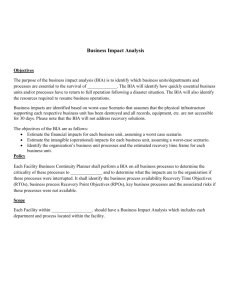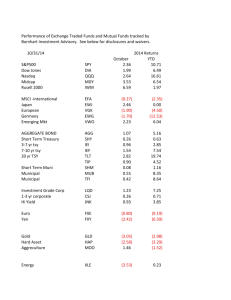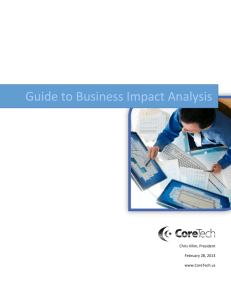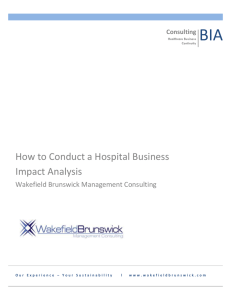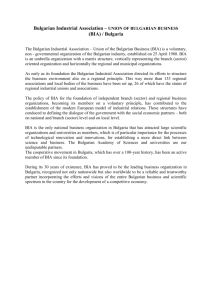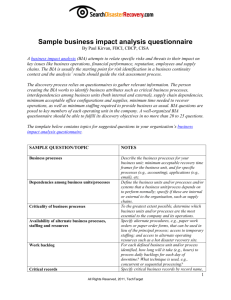Building a Business Impact Analysis (BIA) Process
advertisement
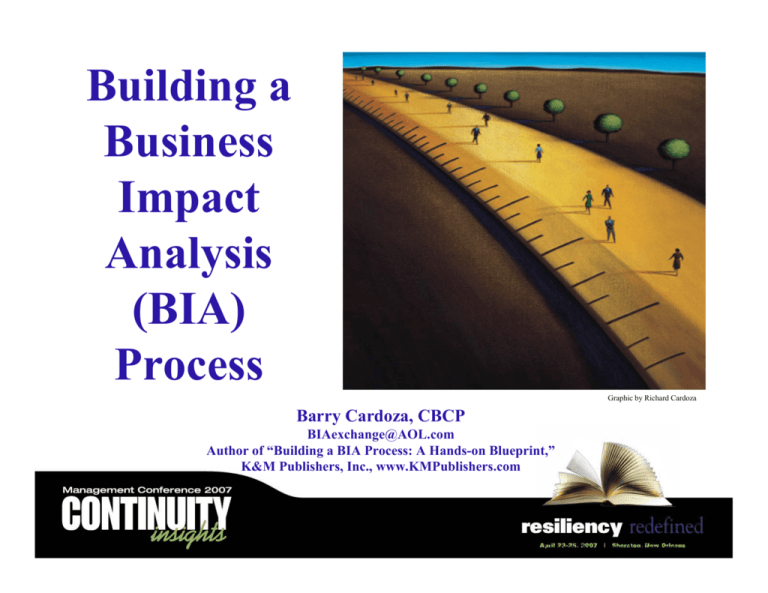
Building a Business Impact Analysis (BIA) Process Graphic by Richard Cardoza Barry Cardoza, CBCP BIAexchange@AOL.com Author of “Building a BIA Process: A Hands-on Blueprint,” K&M Publishers, Inc., www.KMPublishers.com Copyright, Barry A. Cardoza, 2006 What Is a Business Impact Analysis ? The BIA measures the potential quantifiable and qualifiable impact that could occur if any business function was unable to operate for a period of time for any reason. That measurement becomes the basis on which we prioritize our efforts in building an efficient Business Continuity Plan (BCP). The Federal Financial Institutions Examination Council (FFIEC) has said that “the institution’s first step in building a Business Continuity Plan (BCP) is to perform a BIA.” Other regulators are making similar statements. BIA is Not a Threat Analysis BIA is Not a Facility Risk Analysis/Assessment Business unit managers aren’t the best people to ask about the potential cost of facility loss. For that, one would need to speak with the people who can estimate those costs, and that would probably involve real estate people, engineers, technology resources, records managers, and many other people both inside and outside the institution who have expertise in their own specific areas. It basically comes down to doing an inventory of what would be lost. A BIA is Not A Risk Analysis • A Risk Analysis identifies operational risks, defines controls to mitigate those risks, and monitors residual risk that remains after the controls have been put into place. • The BIA identifies the quantitative (measurable) and qualitative (usually reputational) impact that could occur if a Department or Business Function was unable to function for any reason. However, if your company wants to put Threat Analysis, Risk Analysis, or whatever under the BIA “umbrella,” no problem. All aspects will need to be covered in a comprehensive Business Continuity Plan. A business continuity plan that is not predicated on or guided by the results of a business impact analysis (BIA) is at best guesswork, is incomplete, and may not function as it should during an actual recovery. Eugene Tucker, CPP, CFE, CBCP Risk Analysis and the Security Survey Butterworth-Heinemann, Copyright 2006 Graphic by Richard Cardoza Graphic by Richard Cardoza It’s a Process, Not a Project If you plan your BIA as a project that is going to happen every so many months or years, two things will happen: • First, you will be “dinged” by everyone who reviews/audits your BIA because they will say your data is out of date. • Second, you’ll need to admit they’re right! The BIA needs to be a continuous process that will keep your data up-to-date and not overwhelm you. So how do you make your BIA a continuous process? 1) By making sure that you will have a continuous flow of current data regarding the status of your Departments and Business Functions. 2) Establishing a cycle in which the Departments will review and update their data on an annual or (preferably) more frequent basis. 3) Stressing to your departments that the first time around is the hardest. After that, it’s just about a periodic review to note what may have changed in their business environment. Gaining Executive Support • Regulators expect us to have a BIA • Auditors expect us to have a BIA • Customers expect us to have a BIA • Insurers expect us to have a BIA • Board Directors expect us to have a BIA • Shareholders/investors expect us to have a BIA. Gaining Executive Support • For an institution to accurately determine recovery goals and establish recovery priorities, it is essential to know where impact could occur, and how much impact could occur in each area of the institution. • The BIA not only ensures that we apply our resources appropriately toward protecting the company’s most critical assets, it also saves the unnecessary expense of applying an inappropriate level of resources to less critical areas. Include Stakeholders in the Planning Process • Regulators • Compliance • Risk Management • Audit, both internal and external • Executive Management • Line-of-business departments If they are not happy with the results, you won’t be happy either. Define the High-level Goals • Goal #1: Identify the impact that any individual Department or Business Function could have on the institution if it was unable to function for any reason. • Goal #2: Have a final deliverable that will satisfy Goal #1 in clear and understandable language. • Goal #3: Make the process as easy as possible for the Departments. Determine What You Need to Learn • Where could critical financial (quantifiable) impact occur and what is the potential amount of the impact? • Where could critical reputational (qualifiable) impact occur and what is the potential amount of the impact? (Where” can mean two very different and equally important things. Do we mean within which department, or do we mean within which geographic region?) • When would critical impact occur and what is the effect of the impact over a timeline? Define “Critical Impact” • The definition of critical impact needs to be based upon something measured, proven, and dynamic enough to change as your company changes. • You won’t know the appropriate definition of critical impact until you have implemented a BIA process that can keep up with changes in the company. • What is considered non-critical today could become critical tomorrow. Note that the “A” in “BIA” stands for “Analysis,” not subjective opinion. It is important that we remove as much subjectivity as possible. One Definition of “Critical” Impact “Critical Impact is any hard dollar or reputational loss that could endanger the survival of the company. “To determine what is critical, the impact represented by every area of the company must be compared to the company as a whole. “We won’t have documentation showing what is truly critical until we have performed a BIA. “The BIA provides the measurements to determine what is critical at any given time.” Define Impact Categories That Are Appropriate For the Particular Institution • Impact can occur within different Departments or Business Functions in different ways. • Different types of impact can have different measurables to be used for determining the extent of potential impact. • Defining Impact Categories can make it easier for a Department to respond because they have a “prompt” to consider various potential types of impact. Quantifiable Impact Categories for a financial institution might include: •· Inability to collect or receive payments •· Inability to process and record payments •· Inability to invest funds •· Inability to set up new customers •· Inability to make price, structure, or rate changes •· Regulatory/contractual impact •· Inability to meet federal processing deadlines •· Penalties for delayed tax filings •· Penalties for delayed benefits filings •· Penalties for failure to meet regulatory deadlines •· Liability for failure to meet agreements with customers Quantifiable Impact Categories for a retail company might include: •· Inability to record sales •· Inability to accept returns •· Inability to process credit cards, checks, gift cards, certificates •· Inability to replenish merchandise •· Inability to move merchandise between locations •· Inability to respond to customer communications •· Inability to advertise Quantifiable Impact Categories for a manufacturing company might include: •· Inability to order materials •· Inability to receive materials •· Inability to assemble materials •· Inability to advertise products •· Inability to process orders •· Inability to ship products •· Inability to collect payment None of these examples are by any means comprehensive or “boilerplate.” Every company needs to define the measurables and categories that are relevant to them. The important thing is that you must take the time to define your measurables and impact categories, and decide exactly how you are going to use them, before you begin to collect any data. Define Your Deliverables Report #1: Compared to other Departments or Business Functions in the company, each Department/Function’s criticality is this. Report #2: Based on when a Department/Function could cause Quantifiable Impact, its Recovery Time Objective (RTO)would be this. Report #3: Based on when a Departmental/Function could cause Qualifiable/Reputational Impact, its RTO would be this. You can’t perform your analysis until you have collected your data. So, isn’t it reasonable to assume that the final analysis is the last thing you will need plan? CART DATA ANALYSIS CHICKEN HORSE EGG Which comes first…….? Actually, the Analysis Phase and the final product are the FIRST thing you need to consider. You won’t know what data to collect until you know what must be included in the final product. Decide what the final deliverable will include and what it will look like. Sample Data Department X Let’s take a look at the data elements that make up this sample report. Sample Data We’re showing the department’s daily volume in dollars, so we know that we will need to collect that information. Sample Data We’re showing the department’s daily volume in number of transactions, so we will need to collect that information. Sample Data We’re showing the department’s ability to process a percentage of backlog, over and above their normal daily volume. Sample Data And, of course, we’re asking for the potential dollar impact if this unit cannot function for any reason. Sample Data 4 That’s all of the data elements. Everything else in this report^is a calculation or notation. Sample Data However…. If we wanted a report that would also show potential Reputational Impact, then we would need to ask about that type of impact as well. This department processes transactions for businesses. If we have a crisis, they will understand a delay of a few hours. But, depending on the business, some of them will not be able to tolerate a delay over 24 hours, and others would be unable to tolerate a delay of longer than 8 hours. Hey….that’s 5 data elements…. We’re showing the department’s daily volume in number of transactions, so we will need to collect that information. Sample Data The number of transactions is interesting to have, but is probably not particularly useful to the analysis. In-house or Outsource; Buy or Build? • Do you have the resources you need or will you need to bring in some assistance? • Do you have the in-house expertise to develop a “tool” to manage, analyze, and report on the data? • Have you established your Goals and Objectives For a BIA and defined the deliverables?” If not, stop here before considering a service or a product. • If you don’t know what you want to accomplish with a BIA, you won’t know if what is being offered will satisfy your needs. Bottom-up or Top-down? The Right Approach To Your BIA • Intuitively, we know that we must include an evaluation of all our Business Functions in the BIA. • But will the BIA actually be done at the Business Function Level or at the Departmental level? • A Department can have many Business Functions, and those Business Functions can span across Departments. • Corporate management tends to think in terms of “Departments” because that is how the management structure is aligned. You could do your analysis by Department, including all of the Business Functions within each Department, and then identify the Dependencies of each Business Function, Identifying Dependencies • System/technology dependencies • Vendor dependencies • Supporting internal department dependencies • Other dependencies While Dependency identification could be an entirely separate process, incorporating it into your BIA can add significant value to the final deliverables. Topple the Silos When Measuring Impact • To ask managers to prioritize their own Departments without giving them a company-wide perspective is, in effect, forcing them to think in a silo. • The highest priority on one manager’s list might have negligible impact when compared to Departments in other areas of the company. • Don’t ask managers to prioritize their Business Functions. Ask managers to give you the information you need in order to prioritize their Functions in comparison to the company as a whole. Impact & RTO; About How Much or When? And the answer is...it depends on what you want to know. If you want to know which Departments are the most critical, a report such as this one should provide the answer. However… Impact & RTO; About How Much or When? If you want to establish recovery goals/priorities, then this report (over a timeline) would be a better representation of the potential impact. Which departments need to recover first to avoid impact? The Data Collection Phase You have options regarding the way you collect your BIA data: 1) Distribute a survey 2) Meet with individual Department managers 3) Gather groups of managers into a room for a workshop 4) Any combination of the above Asking the Right People Who should you ask to get the BIA information you need from individual Departments? 1) The best approach is probably to start as high on the organizational chart as possible, and then drill down. 2) If high-level management decides it is appropriate to delegate, that’s OK, and it also means you should have their support in getting responses. 3) But even if the work is delegated, your contact should be at the managerial level. Someone needs to “sign off” on the data that is being provided. Asking the Right Questions in the Right Way 1) Put a box around your questions so they cannot possibly be misinterpreted and options for answers are limited. For example, don’t ask “what is your daily volume?” • Volume on what day? • Are we asking for an average? • If so, over what time period? • How else might a manager interpret this question? Instead ask, “what was the volume in dollars on the busiest day of last year” (or other period) if that is what we really want to know. Asking the Right Questions in the Right Way 2) State up-front that you are looking for the “worst case scenario.” 3) Define all terms, even if you think everyone knows the definitions. 4) Be careful how you structure the questions. Some companies choose to offer ranges of numbers, rather than asking for specific numbers. However…. Be careful because this…. …could become this. The Analysis Phase; Remember the Deliverables We wanted to generate reports that would show, clearly and concisely: 1) Where could critical financial (quantifiable) impact occur and what is the potential amount of the impact? 2) Where could critical reputational (qualifiable) impact occur and what is the potential amount of the impact? 3) When would critical impact occur and what is the effect of the impact over a timeline? The very FIRST thing we do is combine all of the data we have collected into a company-wide picture. Sample Data 48 You won’t want to analyze individual Departments/Functions until you have a company-wide baseline to which they can be compared. Once we have the company-wide baseline, we can compare each department to that baseline and begin to see how our departments rank in perspective to each other and to the company as a whole. Department X Department Y Department Z Department W We’ve Covered “How Much and When; ” What About “Where?” If a geographic Region in which you do business is impacted by a crisis, wouldn’t you want to know the potential impact? We Collected Impact Data by Location of Potential Impact; Here’s Why. If you know where your Departments and Business Functions are located…. …and the BIA has identified the potential impact that they could represent if they cannot function for any reason…. …then if Pomona (for instance) is impacted by a crisis…. …you can estimate the potential impact to your company. GeoAnalysis We can use the first three digits of any Zip Code to do geographic analysis 701 would identify the city of New Orleans, LA. Expanding that range to Gramercy 700-701 would also include: Laplace Kenner Metarie Chalmette Lutcher Avondale South Vacherie Marrero Timberlane Des Allemands Etc. GeoAnalysis What if we wanted to focus on facilities or employees in the San Francisco Marina District? (Which was more heavily impacted than other areas of San Francisco by the 1989 Loma Prieta Earthquake.) Then we could filter on all 5 digits of the ZIP code because 94123 is the ZIP code for the Marina District. Have we met the high-level goals ? • Goal #1: Identify the impact that any individual Department or Business Function could have on the institution if it was unable to function for any reason. • Goal #2: Have a final deliverable that will satisfy Goal #1 in clear and understandable language. • Goal #3: Make the process as easy as possible for the Departments. Have we produced the deliverables ? Report #1: Compared to other Departments or Business Functions in the company, each Department/Function’s criticality is this. Report #2: Based on when a Department/Function could cause Quantifiable Impact, its Recovery Time Objective (RTO)would be this. Report #3: Based on when a Departmental/Function could cause Qualifiable/Reputational Impact, its RTO would be this. Departments/Functions by Criticality Impact by Impact Category Impact Analysis by Department 49-72 hrs. Impact by Geographic Region Impact by Geographic Region Over a Timeline, by Category Dependency Identification You will want to have a lot of different views of the data included in your BIA Analysis/product, for different purposes and for different audiences. The good news is that, since you decided on what you wanted for your final product FIRST, you have all of the data you need to provide ALL of these views. And more…. With proper planning and implementation, we have what we need to accomplish our Goals and Objectives. Questions?
